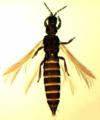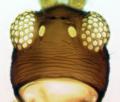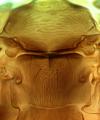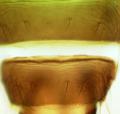Thrips magnus
Recognition data
Distinguishing features
Both sexes fully winged. Body and legs dark brown, major setae brown; antennae brown but pedicel of segment III pale; fore wings uniformly brown. Head slightly wider than long, with curved cheeks; two pairs of ocellar setae; pair III arising on anterior margins of ocellar triangle; postocular setae pair I almost as long as ocellar setae III. Antennae 7-segmented; segments III–IV with forked sensorium. Pronotum smooth or with some faint transverse lines; 2 pairs of long posteroangular setae; posterior margin with 3 pairs of setae, median pair long. Metanotum with irregularly elongate reticulation medially, at anterior with irregularly transverse lines, some markings between the reticles; median setae arising behind anterior margin; campaniform sensilla present. Fore wing first vein with 3 setae on distal half; second vein with row of about 11 setae. Abdominal tergite II with 3 lateral marginal setae; sculpture on median tergites extending to median pair of tergal setae; tergites V–VIII with paired ctenidia laterally, on VIII posteromesad to spiracles; tergite VIII posteromarginal comb absent medially, with slender microtrichia laterally; pleurotergites without discal setae. Sternite II with 2 pairs of marginal setae, III–VII with 3 pairs; sternites without discal setae.
Male smaller than female; tergite VIII comb with a few small microtrichia laterally; tergite IX with median pair of setae arising from distinct tubercles; sternites III–VII with broadly oval pore plate.
Related and similar species
The genus Thrips is the second largest genus in the Thysanoptera, and currently includes, worldwide, about 285 species. T. magnus is one of the largest members of the genus, with particularly dark fore wings and dark antennae. It is similar to T. madronii but can be distinguished by the weak sculpture on the pronotum, and the more extensive sculpture lines on the tergites. Moreover, the males have a glandular area on sternite VII. All members of genus Thrips lack ocellar setae I on the head, and they all have ctenidia on tergite VIII posteromesad to the spiracles. Other characters, such as number of antennal segments, number of setae on the fore wing veins, and number of discal setae on the sternites are variable between species (Palmer, 1992; Nakahara, 1994; Mound & Masumoto, 2005).
Taxonomic data
Current valid name
Thrips magnus Moulton
Original name and synonyms
- Thrips magnus Moulton, 1911: 36
Family placement
Thripidae, Thripinae
Biological data
Life history
Presumably breeding in flowers
Host plants
Apparently associated with Mimulus (Scrophulariaceae).
Tospoviruses vectored
None
Crop damage
None
Distribution data
Area of origin
Western USA
Distribution
California, Utah








